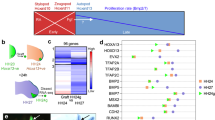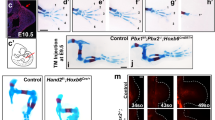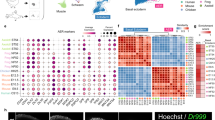Abstract
The expression pattern and activity of fibroblast growth factor-8 (FGF8) in experimental assays indicate that it has important roles in limb development1,2,3, but early embryonic lethality resulting from mutation of Fgf8 in the germ line of mice has prevented direct assessment of these roles4. Here we report that conditional disruption of Fgf8 in the forelimb of developing mice bypasses embryonic lethality and reveals a requirement for Fgf8 in the formation of the stylopod, anterior zeugopod and autopod. Lack of Fgf8 in the apical ectodermal ridge (AER) alters expression of other Fgf genes, Shh and Bmp2.
This is a preview of subscription content, access via your institution
Access options
Subscribe to this journal
Receive 12 print issues and online access
$209.00 per year
only $17.42 per issue
Buy this article
- Purchase on Springer Link
- Instant access to full article PDF
Prices may be subject to local taxes which are calculated during checkout






Similar content being viewed by others
References
Heikinheimo, M., Lawshe, A., Shackelford, G.M., Wilson, D.B. & MacArthur, C.A. Fgf-8 expression in the post-gastrulation mouse suggests roles in the development of the face, limbs and central nervous system. Mech. Dev. 48, 129–138 (1994).
Mahmood, R. et al. A role for Fgf-8 in the initiation and maintenance of vertebrate limb bud outgrowth. Curr. Biol. 5, 797–806 (1995).
Crossley, H.P., Minowada, G., MacArthur, C.A. & Martin, G.R. Roles for Fgf-8 in the induction, initiation and maintenance of chick limb development. Cell 84, 127–136 (1996).
Meyers, E.N., Lewandoski, M. & Martin, G.R. An Fgf8 allelic mutant allelic series generated by Cre- and Flp-mediated recombination. Nature Genet. 18, 136–141 (1998).
Rubin, L. & Saunders, J.W. Ectodermal-mesodermal interactions in the growth of limb buds in the chick embryo constancy and temporal limits of the ectodermal induction. Dev. Biol. 28, 94–112 (1972).
Wolpert, L., Lewis, J. & Summerbell, D. Morphogenesis of the vertebrate limb. Ciba Found. Symp. 29, 95–130 (1975).
Vogel, A., Rodriguez, C. & Izpisua-Belmonte, J.C. Involvement of FGF8 in initiation, outgrowth and patterning of the vertebrate limb. Development 122, 1737–1750 (1996).
Ohuchi, H. et al. Involvement of androgen-induced growth factor (Fgf-8) gene in mouse embryogenesis and morphogenesis. Biochem. Biophys. Res. Commun. 204, 882–888 (1994).
Cohn, M.J., Izpisúa-Belmonte, J.C., Abud, H., Heath, J.K. & Tickle, C. Fibroblast growth factors induce additional limb development from the flank of chick embryos. Cell 80, 739–746 (1995).
Riddle, R.D., Johnson, R.L., Laufer, E. & Tabin, C. Sonic Hedgehog mediates the polarizing activity of the ZPA. Cell 75, 1401–1416 (1993).
Niswander, L., Tickle, C., Vogel, A., Booth, I. & Martin, G.R. FGF-4 replaces the apical ectodermal ridge and directs outgrowth and patterning of the limb. Cell 75, 579–587 (1993).
Colvin, J.S., Feldman, B., Nadeau, J.H., Goldfarb, M. & Ornitz, D.M. Genomic organization and embryonic expression of the mouse fibroblast growth factor 9 gene. Dev. Dyn. 216, 72–88 (1999).
Moon, A.M., Boulet, A.M. & Capecchi, M.R. Normal limb development in conditional mutants of Fgf4. Development 127, 989–996 (2000).
Sun, X. & Martin, G. Conditional inactivation of Fgf4 reveals complexity of signaling during limb bud development. Nature Genet. 25, 83–86 (2000).
Thomas, K.T. & Capecchi, M.R. Site-directed mutagenesis by gene targeting in mouse embryo-derived stem cells. Cell 51, 503–512 (1987).
Dymecki, S.M. Flp recombinase promotes site-specific recombination in embryonic stem cells and transgenic mice. Proc. Natl Acad. Sci. USA 93, 6191–6196 (1996).
Reynolds, K., Mezey, E. & Zimmer, A. Activity of the B-retinoic acid receptor promoter in transgenic mice. Mech. Dev. 36, 15–29 (1991).
Mendelsohn, C., Ruberte, E., LeMeur, M., Morriss-Kay, G. & Chambon, P. Developmental analysis of the retinoic acid-inducible RAR-B2 promoter in transgenic animals. Development 113, 723–734 (1991).
Rowe, D.A. & Fallon, J.F. The effect of removing posterior apical ectodermal ridge of the chick wing and leg on pattern formation. J. Embryol. Exp. Morph. 65, 309–325 (1981).
Ohuchi, H. et al. The mesenchymal factor, FGF10, initiates and maintains the outgrowth of the chick limb bud through interaction with FGF8, an apical ectodermal factor. Development 124, 2235–2244 (1997).
Min, H. et al. Fgf-10 is required for both limb and lung development and exhibits striking functional similarity to Drosophila branchless. Genes Dev. 12, 3156–3161 (1998).
Sekine, K. et al. Fgf10 is essential for limb and lung formation. Nature Genet. 21, 138–141 (1999).
Xu, X. et al. Fibroblast growth factor receptor 2-mediated reciprocal regulation loop between FGF8 and FGF10 is essential for limb induction. Development 125, 753–765 (1998).
Laufer, E., Nelson, C.E., Johnson, R.L., Morgan, B.A. & Tabin, C. Sonic hedgehog and Fgf-4 act through a signaling cascade and feedback loop to integrate growth and patterning of the developing limb bud. Cell 79, 993–1003 (1994).
Niswander, L., Jeffery, S., Martin, G.R. & Tickle, C. A positive feedback loop coordinates growth and patterning in the vertebrate limb. Nature 371, 609–614 (1994).
Ros, M.A. et al. The limb field mesoderm determines initial limb bud anteroposterior asymmetry and budding independent of sonic hedgehog or apical ectodermal gene expressions. Development 122, 2319–2330 (1996).
Lewandoski, M., Sun, X. & Martin, G.R. Fgf8 signalling from the AER is essential for normal limb development. Nature Genet. 26, 460–463 (2000).
Tabin, C. A developmental model for thalidomide defects. Nature 396, 322–323 (1998).
Rogala, E.J., Wynne-Davis, R., Littlejohn, A. & Gormley, J. Congenital limb anomalies: frequency and aetiological factors. J. Med. Genet. 11, 221–233 (1974).
Tanaka, A. et al. Cloning and characterization of an androgen-induced growth factor essential for the androgen-dependent growth of mouse mammary carcinoma cells. Proc. Natl Acad. Sci. USA 89, 8928–8932 (1992).
Acknowledgements
We thank J. Tomlin for technical assistance; vivarium staff for their ongoing efforts; members of the Capecchi laboratory for input and critical reading of the manuscript; L. Oswald for assistance with preparing the manuscript; A. McMahon, B. Hogan, C. Deng and D. Ornitz for in situ probes; and J. Deschamps for the RAR β2 promoter fragment.
Author information
Authors and Affiliations
Corresponding author
Rights and permissions
About this article
Cite this article
Moon, A., Capecchi, M. Fgf8 is required for outgrowth and patterning of the limbs. Nat Genet 26, 455–459 (2000). https://doi.org/10.1038/82601
Received:
Accepted:
Issue Date:
DOI: https://doi.org/10.1038/82601



